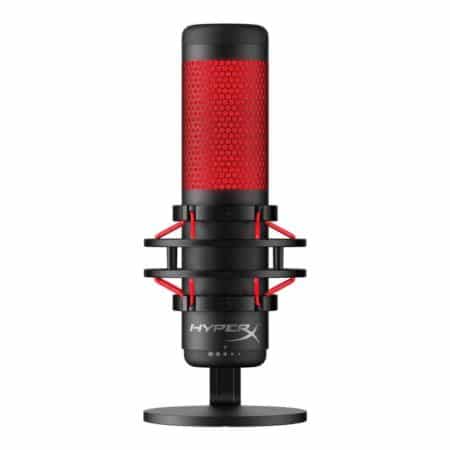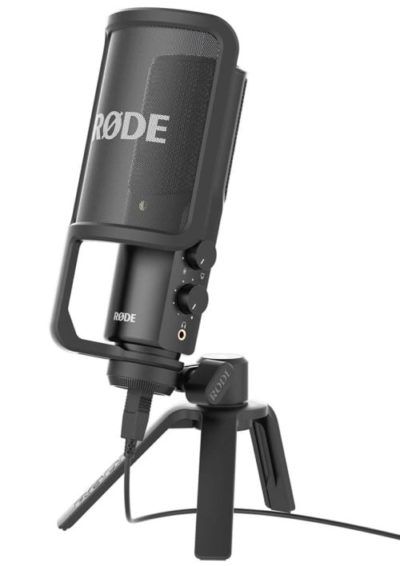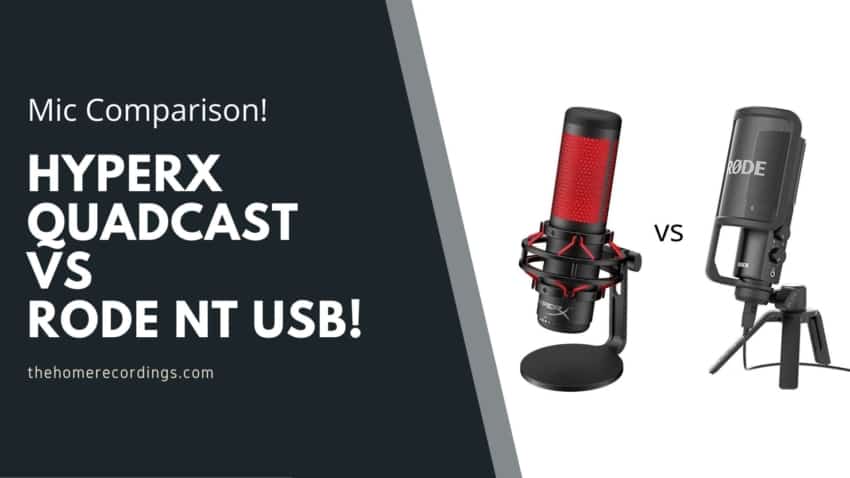Last updated on December 29th, 2023 at 09:56 pm
The Rode NT USB has been a staple in the recording industry for years now, and in fact, I owned one for quite a while (Video review later on).
HyperX came out with the Quadcast, which is a microphone that is almost identical to the Blue Yeti in every way, but very different from the Rode NT USB.
In this article, I will go over the differences between them, their overall features, and which one I believe you should get.
So, without any further ado, let’s get started!
Differences
The HyperX Quadcast offers Cardioid, Omni & Bidirectional, as well as Stereo polar patterns, making it a very versatile microphone.
The Rode NT USB only features a cardioid polar pattern, but the audio quality and build quality are much better, making it the best overall choice since you will only be using a cardioid pattern most of the time.
Let’s get into the specifics of each microphone, their features, and more!
HyperX Quadcast

So, firstly this microphone is clearly aimed towards gamers who want to stream their gameplay, or just YouTubers in general, because of the way it looks.
Of course, it can be used to do almost anything since it’s a very versatile microphone, but even though I like its appearance, it’s definitely not as professional-looking as some other microphones, including the Rode NT USB.
The HyperX Quadcast comes with the following pickup patterns: Cardioid-, Omni-, Bi-directional-, and stereo patterns.
It comes attached to a desk-stand that also has a built-in shock mount, and this is definitely a really nice bonus to have since it will either completely avoid picking up unwanted vibrations coming from the desk, or at least reduce them significantly.
Note: The Rode NT USB doesn’t come with a built-in shock mount.
On the back of the microphone you’ll have access to the USB connection and to a headphone jack that lets you do zero-latency monitoring.
Once the microphone is connected and working, it will light up in a really nice red color (I used to think that this was the color of the microphone itself, but it’s actually thanks to the internal lighting).
On the top of the microphone you’ll find a touch-sensitive “Mute” button; When the mic is muted, the background light inside the microphone will turn off.
This is a really nice feature to have for two reasons; Most USB microphones don’t have this option and you need to turn the Gain dial all the way down if you want to mute it, and getting the exact same level afterwards can be tricky.
This way you only need to unmute it and you’re back recording at the exact same level.
The other reason is that since the microphone only lights up when it is recording, you’ll have visual feedback when it’s muted or not.
Now, I mentioned that it comes with four different pickup patterns, and while they all may have their place, you’re probably going to be using the cardioid one the most, especially if you’re doing voice-over, singing, Streaming, etc. since it’s designed to only pick up what is right in front of the mic.
The Omni polar pattern is designed to record everything surrounding it, and if you want to do a podcast and only have this microphone, then this would be the polar pattern of choice.
Lastly, the Stereo and Bi-directional patterns are identical, with the only difference being that the bi-directional picks up sound from the front and back, while Stereo picks up sound from both sides.
If you’re interviewing someone, then Bi-directional is the best one, while if you want to record and acoustic guitar for example, stereo would be best.
How does it perform?
For spoken word, voice over, streaming, etc. I found it to be a good microphone; it sounds full and I needed to do little-to-no editing after the recording was done in order to get a professional sound out of it.
For music, on the other hand, I don’t recommend it.
I recorded my acoustic guitar with it and the Stereo Pattern did work quite well, even though it lacked a bit in the lower end.
With the Cardioid pattern however, it sounded way too boomy for my taste, which is kind of the opposite of what happened with the stereo pattern.
Another issue I found was with the pop filter, which is designed to reduce unwanted plosives when you’re talking;
It is definitely far from the best and if you’re going to be speaking straight into the microphone, then I’d highly recommend purchasing an external pop filter, otherwise get ready to re-record everything multiple times.
One other issue popped up when I mounted it on a regular mic-stand using the adapter; there’s little to no room between the mic and the mic-stand and this creates unnecessary pressure on both the USB- and headphone cables…
So, imagine how long those cables will last? Not to mention the USB and headphone connectors themselves.
Now, one huge pro of this microphone is the “Mute” button on the top, which is something I wish more USB microphones would feature, and also that it comes with a shock mount, so yes, there are some really good things that HyperX did right here.
Lastly, this microphone is marketed towards gamers mostly, so why on earth does it need four polar patterns? You only need a Cardioid one as a gamer/streamer and the cost could’ve been significantly lower if they didn’t include the extra three.
This is definitely a con, but some people may use those extra patterns sometime.
What comes in the Box?
- The HyperX Quadcast Microphone
- USB Cable
- Mic Stand adapter
Features
- Tri-capsule array: three condenser capsules inside
- Multiple pattern selection: cardioid, stereo, omnidirectional and bidirectional
- Gain control, mute button, zero-latency headphone output
- Good for podcasting, voiceovers, game streaming, interviews and conference calls
- Plug ‘n play: Mac and PC compatible
- Desk stand included (already attached to the mic)
- Mic-Stand adapter (may hurt the cables)
Specifications
- Polar Pattern; Cardioid, stereo, omni- and bidirectional
- Frequency Response: 20Hz- 20kHz
- Sample Rate: 48kHz/16-bit
- Sensitivity: -36dB
- Weight: 254g
Find out more about the HyperX Quadcast here.
Rode NT USB

The Rode NT USB is an excellent Condenser USB cardioid microphone.
Rode is known for making extremely high-quality equipment at reasonable prices, and the Rode NT USB is no exception to this rule.
It comes with a pop filter, which is extremely good, a tripod desk stand, a ring mount, and a storage pouch.
The two controls on the side are for the headphone volume, which comes in handy when you want to do zero latency monitoring, and the Direct mix control between mic input and source output.
This means that you can choose to hear only what’s coming out of the PC, or to only hear the direct signal from the Mic, or a blend of those two.
Now, you might have noticed that it doesn’t come with a Gain dial, which for a mic in this price-range is just ludicrous.
You can control the levels from your PC however, but this isn’t ideal.
This microphone is pretty good for recording singing and spoken word applications such as podcasting and voice-over.
When looking at the build quality I have to say that it’s just great.
It’s got some weight to it and it doesn’t feel at all flimsy or delicate.
Like I mentioned, it includes a pop filter which is rare since most microphones don’t include one, and even though it feels a bit cheap, it’s still a free pop filter that works.
Lastly, it works on Windows and Mac OS based computers, as well as the Apple iPad.
How does it perform?
To be honest, I wasn’t as surprised as I thought I would be when trying out this mic.
For spoken word applications or for quiet singing it works super well, however when recording instruments that are a bit too loud, or any other loud sound source for that matter, even if the signal doesn’t clip, it will sound as if it’s clipping.
Also, having no Gain dial makes it a bit of a pain to set the levels correctly…
Other than that, I think that the Rode NT USB does a pretty decent job at doing what it’s supposed to do, just remember to not record very hot signals.
Now, there is one important thing to consider when thinking about getting the Rode NT USB, since it literally costs twice as much in certain European countries than in the US.
I have seen it in the Amazon Store in Germany for almost the same as in the US, but in Spain, and other countries, it sells for twice as much.
In this case, you could actually purchase an Audient iD14, which is an insanely good Audio Interface, plus an XLR microphone and have a much better setup for the same money.
What comes in the box?
- The Rode NT USB Microphone
- Pop Filter
- Microphone Stand
- Microphone Mount
- Storage Pouch
Features
- Polar Pattern: Cardioid
- Pop shield, Tripod desk stand, ring mount, storage pouch and 6m (20’) USB cable included
- Includes Headphone Jack
- Frequency Response: 20Hz -20KHz
- Sample Rate: 48KHz/16-bit
Specifications
- Polar Pattern; Cardioid
- Frequency Response: 20Hz- 20kHz
- Sample Rate: 48kHz/16-bit
- Max SPL: 110dB
- Weight: 520g
Find out more about the Rode NT USB here.
- Rode NT USB: Amazon, Sweetwater.
Which one should you choose?
I generally don’t recommend the Rode NT USB because, even though it’s built like an absolute tank, it suffers from that “high Gain” issue I mentioned earlier, which means that recording loud sources, even with the gain set to zero, will be impossible.
For spoken word, singing, recording acoustic instruments, etc., it’s an absolutely fantastic microphone that also comes with a pop filter, which is rare with microphones in this price range.
In this particular case, I would highly recommend the Rode NT USB over the HyperX Quadcast, since that one is designed as a gamin/streaming microphone, meaning that it will only be recording your voice and not loud instruments, and therefore the Rode ends up being better.
The only reason I can see myself recommending the Quadcast is if you need to take advantage of all those polar patterns, but I assure you that in 99% of the cases, you will be using the cardioid one.
So, go with the Rode NT USB.
